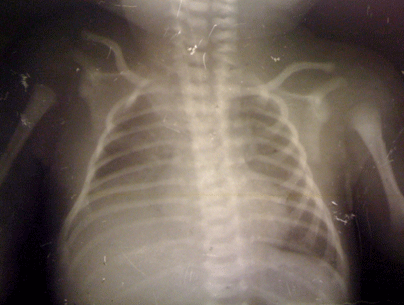Shoulder Dystocia and Diaphragmatic Hernia
Keywords:
Diaphragmatic eventration, Phrenic nerve, Dystocia.Abstract
Introduction: shoulder dystocia is an unpredictable event that can be mild or severe. In the neonatal period is the most important risk factor for brachial plexus injury and an exceptional cause of diaphragmatic hernia by phrenic nerve injury.Case presentation: a newborn is presented after a shoulder dystocia delivery, born severely depressed and whose evolution requires prolonged ventilatory support.
Conclusions: in the fluoroscopic study we concluded right diaphragmatic hernia, with respiratory distress syndrome approximately of one month of evolution and without requiring surgical treatment to date. The most frequent complications were repeated bronchopneumonia and atelectasis. An updated review of the literature highlighting etiologic diagnosis was made. Photos are presented prior parental consent.
Downloads
References
1-Cuba, Ministerio de Salud Pública. Consenso de procederes diagnósticos y terapéuticos en Obstetricia y perinatología [CD-ROOM]. Ciudad de la Habana: MINSAP; 2010.
2-Galan Henry L, Gottlieb AG. Distocia de hombros: una actualización. Rev Obstet Ginecol Clin N Am. 2007; 34:501-31.
3-Madi JM, Jacobi RV, Araújo BF, Viecceli C, Barazzetti DO, Pavan GP. Factores de riesgo asociados a traumatismo al nacimiento. Rev Chil Obst Ginecol. 2012; 77(1): 35–9.
4- Jennett RJ, Tarby TJ. Brachial plexus palsy: An old problem revisited again.
Am J obstet Gynecol. 1997; 176:1354-7.
5-Rodríguez Díaz M, Amigo Castañeda P. Una mirada a la parálisis braquial obstétrica. Rev Méd Electrón [Internet]. 2011 Jun-Jul [citado 16 Nov 2012]; 33(4): [aprox. 8p.]. Disponible en: http://www.revmatanzas.sld.cu/revista%20medica/ano%202011/vol4%202011/tema13.htm
6-Ayerza Casas AA, Delgado Bueno M, Samper Villagrasa MP, Rodríguez Martínez G, López Moreno MJ. Parálisis braquial obstétrica en nuestro Servicio: Revisión de 10 años. Revista Española Pediatría. 2010; 66(2): 107-10.
7-Cantú Cárdenas O, Pérez Martínez PY, Rodríguez Balderrama I, Montes-Tapia FF. Plicatura diafragmática por toracoscopia en un neonato. Reporte de un caso. Rev Mex Pediatr. 2005; 72(4): 186-8.
8- Backe B, Magnussen EB, Johansen OJ, Sellaeg G, Russwurm H. Obstetric brachial plexus palsy: a birth injury not explained by the known risk factors. Acta Obstet Gynecol Scand. 2008; 87:1027-32.
9-Pons Odenaa M, Piqueras Marimbaldob I, Colomer Oferilc J, Segura Matutea S, Palomeque Rico A. Enfermedad respiratoria y parálisis diafragmática en la enfermedad de Charcot-Marie-Tooth. An Pediatr (Barc). 2010; 72(4): 267–71.
10-Sarihan H, Cay A, Akyazici R. Congenital diaphragmatic eventration: treatment and postoperative evaluation. J Cardiovasc Surg. 1996; 37:173-6.
11-Samperio González MA, Selvi Blasco M. Parálisis diafragmática unilateral. Form Med Contin Aten Prim. 2010; 17(07): 480-1.
12- Martínez Cerón E, Cabanillas JJ, Ortega Cuesta B, Álvarez Sala R. Elevación diafragmática como hallazgo radiológico de un tumor fibroso aislado de pleura. Revista de Patología Respiratoria.2011; 14(1): 33-5.

Published
How to Cite
Issue
Section
License
Authors who have publications with this journal agree to the following terms: Authors will retain their copyrights and grant the journal the right of first publication of their work, which will be publication of their work, which will be simultaneously subject to the Creative Commons Attribution License (CC-BY-NC 4.0) that allows third parties to share the work as long as its author and first publication in this journal are indicated.
Authors may adopt other non-exclusive license agreements for distribution of the published version of the work (e.g.: deposit it in an institutional telematic archive or publish it in a volume). Likewise, and according to the recommendations of the Medical Sciences Editorial (ECIMED), authors must declare in each article their contribution according to the CRediT taxonomy (contributor roles). This taxonomy includes 14 roles, which can be used to represent the tasks typically performed by contributors in scientific academic production. It should be consulted in monograph) whenever initial publication in this journal is indicated. Authors are allowed and encouraged to disseminate their work through the Internet (e.g., in institutional telematic archives or on their web page) before and during the submission process, which may produce interesting exchanges and increase citations of the published work. (See The effect of open access). https://casrai.org/credit/


